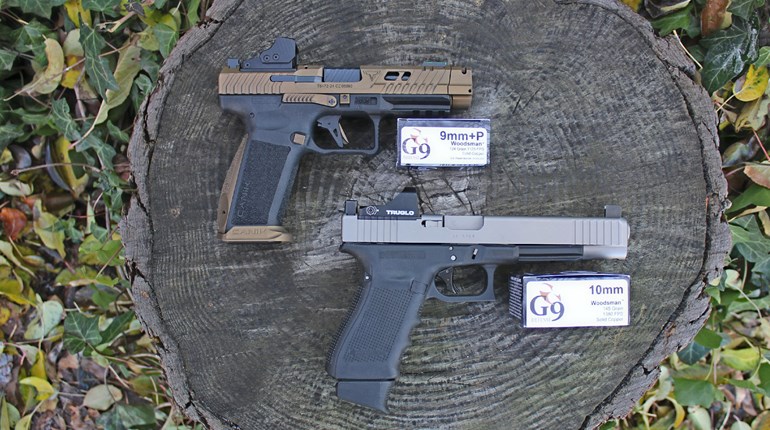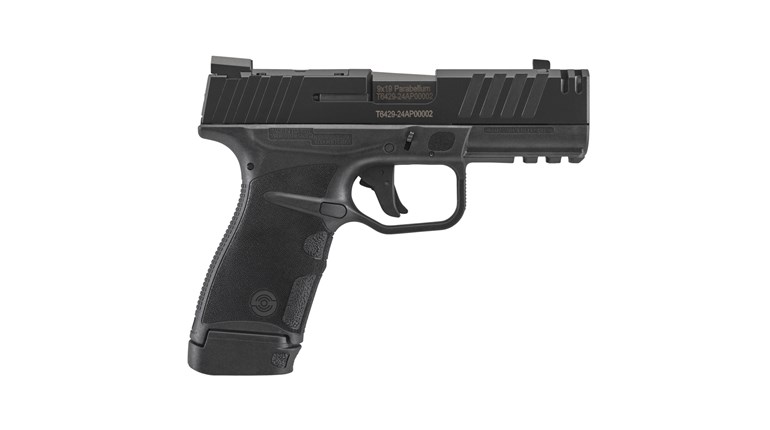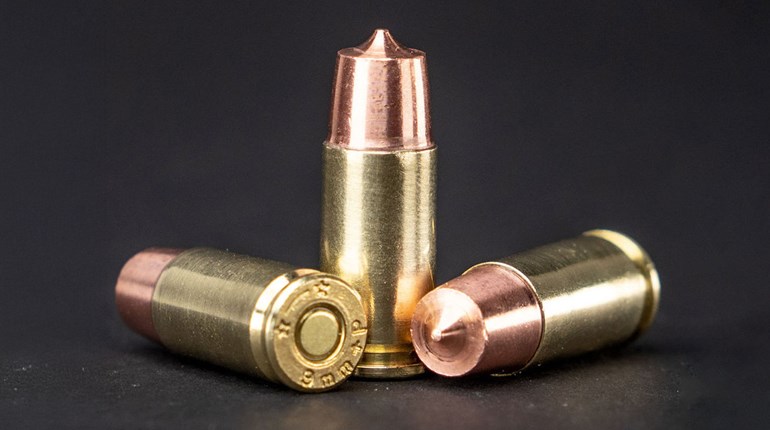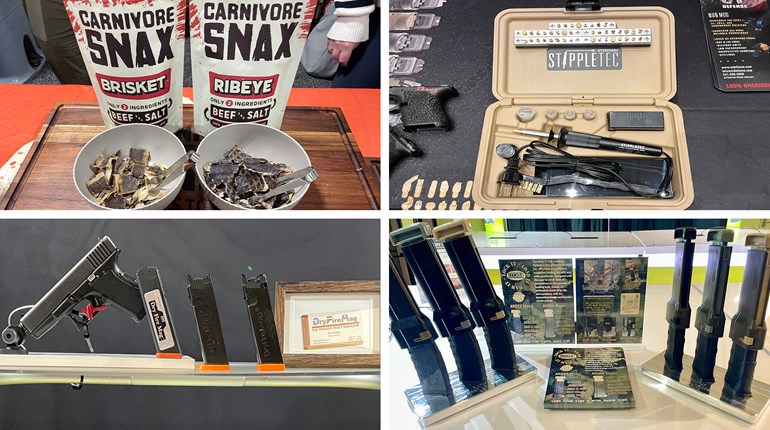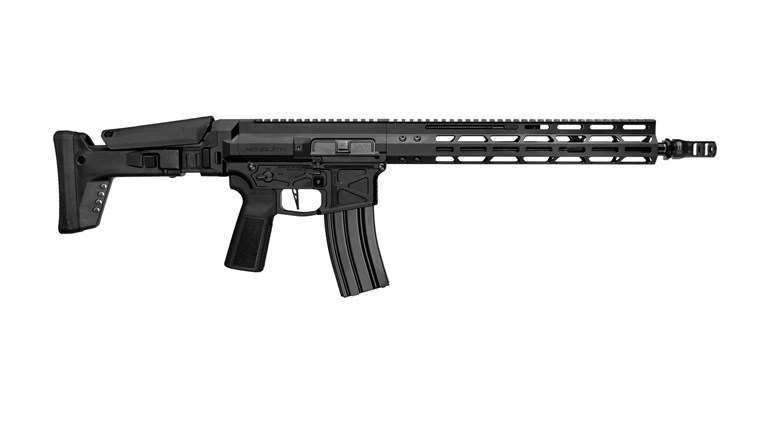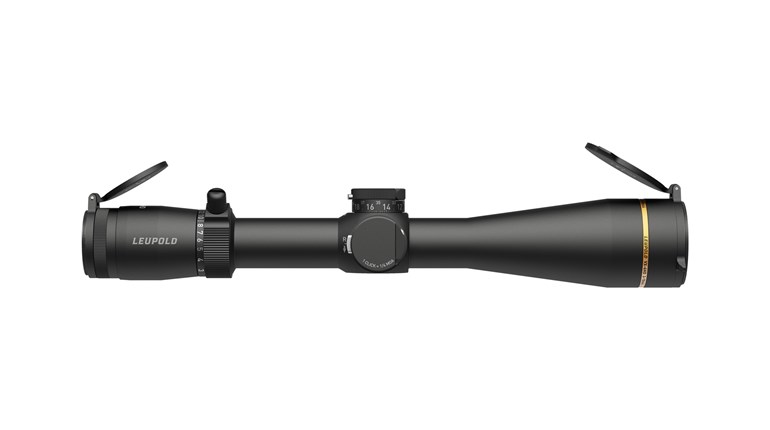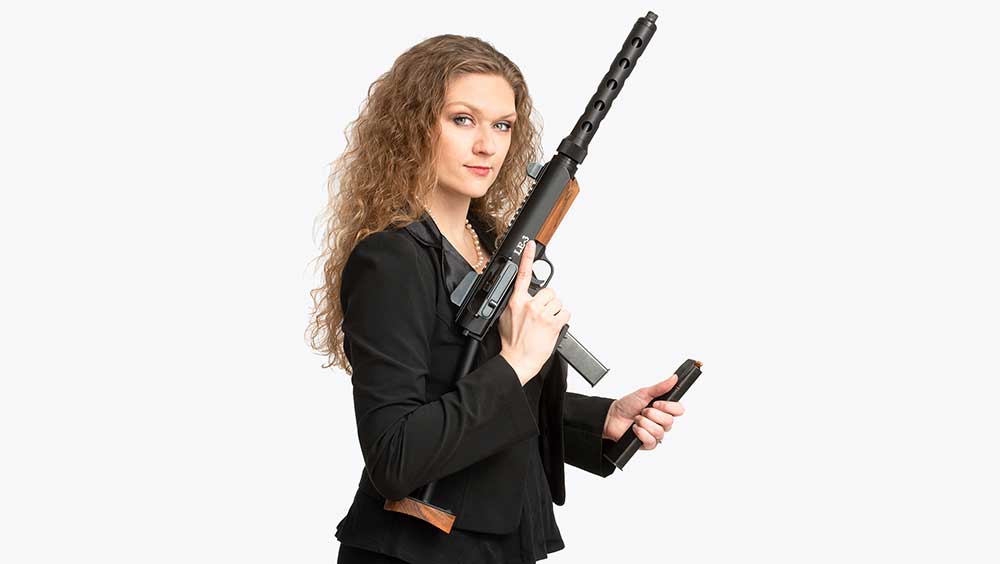
The Wilkinson Arms Linda pistol, as well as the carbine design that came from it, is an excellent example of engineering genius. Fortunately for this uniquely clever design, the modernization of it greatly improved on the original configuration. My first acquaintance with Linda pistol happened at a public library in 1990. A teenager back then, I was looking at one of the popular gun magazines at the time, comparing various guns. Having none of my own and a minimal familiarity with those I had tried up to then, I judged usefulness mainly on the basis of magazine capacity. Holding 31 rounds, the Linda pistol was one of the clear winners in my mind. That, along with its distinctive appearance and unusual model name, firmly planted the name of that gun in my memory. Over time, the knowledge of the pistol and of the similar Terry carbine passed from my consciousness.
Designed during the 1960s by Ray Wilkinson of J&R Engineering, they were originally designated M68 and M80 with law-enforcement use in mind. Later, once J&R was closed and re-incorporated as Wilkinson Arms, the family of 9 mm and rimfire pistols and carbines also became a family in model designations, christened after Ray's wife and daughters. The design then passed to Northwest Arms before the production ceased in 2005, and the Linda pistol and Terry carbine were both seemingly relegated to history.

Then it happened—Wilkinson Arms was bought and revived by a shooting enthusiast Patrick McFarland. In 2015, he acquired the remainder of the unused Linda parts and went about setting up renewed production. I heard about it last year and finally got my hands on the carbine version of Linda pistol. Fitted with a simple tubular buttsock and a 1/2x28 TPI threaded 16-inch barrel, it was a teen dream come true.
Inside its tubular receiver, the Wilkinson Arms Linda uses the enveloping-bolt concept originated with the Czech SA25 and the Israeli Uzi. Going even further than those already compact designs, the Linda uses a bolt almost entirely encircling the barrel, with just enough aft of the chamber to load the next cartridge. Unlike these older guns which use small-diameter recoil springs on guides behind the bolt, Linda uses a larger single spring wrapped around the bolt in front of the chamber. Like the SA25 and the Uzi, the Linda uses a barrel nut. Unlike them, it has a second nut behind the first to retain the bolt.

Also like those two guns, Linda feeds through the pistol grip, improving in the grip angle considerably. Using a double-stack, single-feed magazine, it provides a natural, forward-leaning grip instead of the straight (Uzi) or backward-raked (SA25). Unlike those submachine guns, Linda shoots from the closed bolt, since U.S. firearm law prohibits the manufacture of open-bolt semi-automatics. This requires a slightly heavier bolt and reduces ventilation between bursts of rapid fire. However, a closed-bolt design yields superior accuracy and improved dust sealing of the chamber.
The operating system uses hammer and firing pin rather than a striker, with the trigger feeling lighter than its measured 6.5 pounds of pull, thanks to a smooth, wide trigger face. The cross-bolt safety stands out by feel, so its state can be ascertained without looking. The overhanging receiver sides fence off the safety from accidental interference in both ON (right) and OFF (left) positions. Since the extra-wide ejection port exposes the back of the receiver behind the bolt to outside dust, the Linda uses a hinged cover patterned after the M16.

Takedown is simple but requires tools. Use a 5/32-inch Allen key to remove two screws holding the pistol grip to the receiver. A 3/16-inch Allen key is needed to unscrew the charging handle. Unscrewing the barrel nut releases it, along with the attached ventilated shroud. Using any flat object for a wrench helps unscrew the second nut retaining the bolt, which comes forward with the attached spring. That's the full extent of field-stripping the carbine for cleaning.
The signature 31-shot magazine looks like most pistol mags, except for the addition of over-insertion tabs. Loading is surprisingly easy for the capacity, with no mechanical loader required. The magazine doesn't drop free, whether full or empty. This helps retention but harms reloading speed. The Wilkinson Arms Linda also lacks either automatic or manual bolt hold-open device.
The sights are a reminder that the Linda carbine concept is definitely older. Both front post and rear aperture are fixed for elevation and windage, so matching the point of impact is a matter of luck. They can be bent into regulation, but that's a pretty desperate method. Fortunately, the updated Linda comes with a top rail. Unfortunately, the rail is Weaver spec, not Picatinny. Some Picatinny mount optics fit, like the Primary Arms red dot I mounted. Others, like Magpul sling eyelet, do not. The vestigial sights are removable, but finding Weaver-spec iron sights can be a challenge, and the sight radius is quite limited for a carbine anyway. A left-side charging handle reciprocates safely away from the hands, but its knob position has to be considered when mounting optics to avoid hitting knuckles against the sight.

Ergonomics are a mixed bag. The carbine adds 7.75 inches more barrel length, shrouded against direct heat transfer to the hand, which, together with the buttstock, adds 1.3 pounds to the overall weight, much of it toward the front. The balance is very slightly to the front of the pistol grip but behind the support hand is placed on the re-designed wooden fore-end. The fore-end is made of nicely finished wood, but it has inexplicably sharp edges not present in the old Linda pistol. Similarly, attractive hardwood is used for the stock buttpad, but there's no rubber buttpad. The metal tube which is the buttstock could use neoprene insulation for comfort. The angle of drop is considerable, yet the carbine comes to the shoulder naturally and the eye lines up well with the sights. For people like me who crowd the rear sight and so end up with a higher head position, a slightly raised red dot works better.
The proof of utility is always in the range time. The most important feature of any firearm is reliability, and Linda carbine shines there: no malfunctions with any ammunition ranging from light, fast 50-grain Liberty bullets to Seismic Ammo 185-grain subsonics. Accuracy was also respectable, amply adequate to keep all hits on the A zone of a silhouette target at 100 yards. Since 9 mm is really 100-150 yard cartridge at the most, depending on the load and the barrel length, this seems entirely adequate.

I did my testing with a Primary Arms rotary control 20 mm micro red dot sight, an excellent 2-MOA optic for any pistol-caliber carbine. Rather than mount a magnified scope to wring the smallest groups out of the carbine, I wanted to see what realistic results can be expected in a typical fighting configuration. Due to strong wind on the day of the range trip, all of my groups were wider than they were tall, with the vertical component being more accurate representation of the actual bullet dispersion. Here's what we found for measured groups at 50 yards:
Speer Lawman 147-grain FMJ (1,060 fps): 1.4 inches
Inceptor 65-grain RNP (1,715 fps): 1.3 inches
Liberty 50-grain HP (2,550 fps): 2.15 inches
Fiocchi 115-grain FMJ (1,320 fps): 1.15 inches
Seismic Ammo 185-grain (1,010 fps): 5.5 inches
Curiously, lighter loads grouped higher than heavier at mid-trajectory (50 yards, with zero at 100 yards). For varmint use, the frangible lightweights would be superior, but for everyday plinking and target shooting, the least-expensive, most-common 115-grain load proved the most accurate. Felt recoil is fairly low, to the point where drop stock didn't affect follow-up shots. Lighter-weight bullets produced noticeably less felt recoil, which is a further argument in their favor for rapid fire.
Overall, despite its distinctly dated configuration, the Wilkinson Arms Linda carbine turned out to be comfortable and ergonomic. It only needs sling loops and an optic to keep up with any modern pistol-caliber carbine, and you can't deny that it has a cool, retro look to it that'll turn heads at any range. Overall length measures 31.5 inches with the fixed stock, but AK-style underfolding and collapsible M4-style stocks are also available for it. Unloaded, the gun weighs 6.1 pounds, and the suggested retail price is $825.
Designed during the 1960s by Ray Wilkinson of J&R Engineering, they were originally designated M68 and M80 with law-enforcement use in mind. Later, once J&R was closed and re-incorporated as Wilkinson Arms, the family of 9 mm and rimfire pistols and carbines also became a family in model designations, christened after Ray's wife and daughters. The design then passed to Northwest Arms before the production ceased in 2005, and the Linda pistol and Terry carbine were both seemingly relegated to history.

Then it happened—Wilkinson Arms was bought and revived by a shooting enthusiast Patrick McFarland. In 2015, he acquired the remainder of the unused Linda parts and went about setting up renewed production. I heard about it last year and finally got my hands on the carbine version of Linda pistol. Fitted with a simple tubular buttsock and a 1/2x28 TPI threaded 16-inch barrel, it was a teen dream come true.
Inside its tubular receiver, the Wilkinson Arms Linda uses the enveloping-bolt concept originated with the Czech SA25 and the Israeli Uzi. Going even further than those already compact designs, the Linda uses a bolt almost entirely encircling the barrel, with just enough aft of the chamber to load the next cartridge. Unlike these older guns which use small-diameter recoil springs on guides behind the bolt, Linda uses a larger single spring wrapped around the bolt in front of the chamber. Like the SA25 and the Uzi, the Linda uses a barrel nut. Unlike them, it has a second nut behind the first to retain the bolt.

Also like those two guns, Linda feeds through the pistol grip, improving in the grip angle considerably. Using a double-stack, single-feed magazine, it provides a natural, forward-leaning grip instead of the straight (Uzi) or backward-raked (SA25). Unlike those submachine guns, Linda shoots from the closed bolt, since U.S. firearm law prohibits the manufacture of open-bolt semi-automatics. This requires a slightly heavier bolt and reduces ventilation between bursts of rapid fire. However, a closed-bolt design yields superior accuracy and improved dust sealing of the chamber.
The operating system uses hammer and firing pin rather than a striker, with the trigger feeling lighter than its measured 6.5 pounds of pull, thanks to a smooth, wide trigger face. The cross-bolt safety stands out by feel, so its state can be ascertained without looking. The overhanging receiver sides fence off the safety from accidental interference in both ON (right) and OFF (left) positions. Since the extra-wide ejection port exposes the back of the receiver behind the bolt to outside dust, the Linda uses a hinged cover patterned after the M16.

Takedown is simple but requires tools. Use a 5/32-inch Allen key to remove two screws holding the pistol grip to the receiver. A 3/16-inch Allen key is needed to unscrew the charging handle. Unscrewing the barrel nut releases it, along with the attached ventilated shroud. Using any flat object for a wrench helps unscrew the second nut retaining the bolt, which comes forward with the attached spring. That's the full extent of field-stripping the carbine for cleaning.
The signature 31-shot magazine looks like most pistol mags, except for the addition of over-insertion tabs. Loading is surprisingly easy for the capacity, with no mechanical loader required. The magazine doesn't drop free, whether full or empty. This helps retention but harms reloading speed. The Wilkinson Arms Linda also lacks either automatic or manual bolt hold-open device.
The sights are a reminder that the Linda carbine concept is definitely older. Both front post and rear aperture are fixed for elevation and windage, so matching the point of impact is a matter of luck. They can be bent into regulation, but that's a pretty desperate method. Fortunately, the updated Linda comes with a top rail. Unfortunately, the rail is Weaver spec, not Picatinny. Some Picatinny mount optics fit, like the Primary Arms red dot I mounted. Others, like Magpul sling eyelet, do not. The vestigial sights are removable, but finding Weaver-spec iron sights can be a challenge, and the sight radius is quite limited for a carbine anyway. A left-side charging handle reciprocates safely away from the hands, but its knob position has to be considered when mounting optics to avoid hitting knuckles against the sight.

Ergonomics are a mixed bag. The carbine adds 7.75 inches more barrel length, shrouded against direct heat transfer to the hand, which, together with the buttstock, adds 1.3 pounds to the overall weight, much of it toward the front. The balance is very slightly to the front of the pistol grip but behind the support hand is placed on the re-designed wooden fore-end. The fore-end is made of nicely finished wood, but it has inexplicably sharp edges not present in the old Linda pistol. Similarly, attractive hardwood is used for the stock buttpad, but there's no rubber buttpad. The metal tube which is the buttstock could use neoprene insulation for comfort. The angle of drop is considerable, yet the carbine comes to the shoulder naturally and the eye lines up well with the sights. For people like me who crowd the rear sight and so end up with a higher head position, a slightly raised red dot works better.
The proof of utility is always in the range time. The most important feature of any firearm is reliability, and Linda carbine shines there: no malfunctions with any ammunition ranging from light, fast 50-grain Liberty bullets to Seismic Ammo 185-grain subsonics. Accuracy was also respectable, amply adequate to keep all hits on the A zone of a silhouette target at 100 yards. Since 9 mm is really 100-150 yard cartridge at the most, depending on the load and the barrel length, this seems entirely adequate.

I did my testing with a Primary Arms rotary control 20 mm micro red dot sight, an excellent 2-MOA optic for any pistol-caliber carbine. Rather than mount a magnified scope to wring the smallest groups out of the carbine, I wanted to see what realistic results can be expected in a typical fighting configuration. Due to strong wind on the day of the range trip, all of my groups were wider than they were tall, with the vertical component being more accurate representation of the actual bullet dispersion. Here's what we found for measured groups at 50 yards:
Speer Lawman 147-grain FMJ (1,060 fps): 1.4 inches
Inceptor 65-grain RNP (1,715 fps): 1.3 inches
Liberty 50-grain HP (2,550 fps): 2.15 inches
Fiocchi 115-grain FMJ (1,320 fps): 1.15 inches
Seismic Ammo 185-grain (1,010 fps): 5.5 inches
Curiously, lighter loads grouped higher than heavier at mid-trajectory (50 yards, with zero at 100 yards). For varmint use, the frangible lightweights would be superior, but for everyday plinking and target shooting, the least-expensive, most-common 115-grain load proved the most accurate. Felt recoil is fairly low, to the point where drop stock didn't affect follow-up shots. Lighter-weight bullets produced noticeably less felt recoil, which is a further argument in their favor for rapid fire.
Overall, despite its distinctly dated configuration, the Wilkinson Arms Linda carbine turned out to be comfortable and ergonomic. It only needs sling loops and an optic to keep up with any modern pistol-caliber carbine, and you can't deny that it has a cool, retro look to it that'll turn heads at any range. Overall length measures 31.5 inches with the fixed stock, but AK-style underfolding and collapsible M4-style stocks are also available for it. Unloaded, the gun weighs 6.1 pounds, and the suggested retail price is $825.














